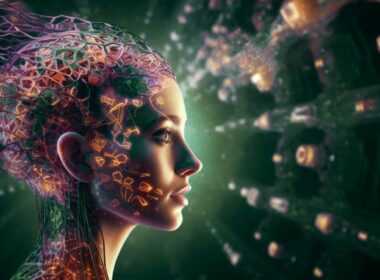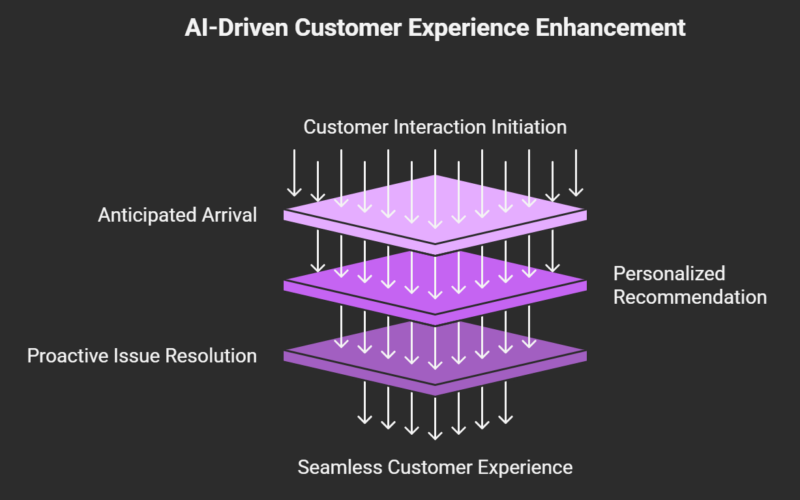“Gaming is not just about pixels and controllers anymore; it’s about intelligent experiences.”
Have you ever wondered what it would be like to play a game that anticipates your every move? Or interact with characters that feel genuinely alive? You’re on the cusp of experiencing just that.
The numbers speak for themselves. A report shows that the global VR gaming market is set to jump to $65.5 billion by 2030, growing at a CAGR of 28.1%. What’s driving this massive growth? AI-powered enhancements that make gameplay more realistic and engaging.
From adaptive enemies to lifelike NPCs, AI/VR development is changing how you play. Games now learn from you, react to you, and evolve with you. This blog will cover how AI is reshaping virtual gaming, the latest breakthroughs, and what’s next for the future of play.
The Evolution of AI in Virtual Reality: From Motion Tracking to Adaptive Worlds
Ever wonder how those virtual worlds feel so, well, real these days? It’s not just fancy graphics anymore. We’re talking about virtual reality in AI, and it’s completely changing the game. Let’s dive into how we got here.
- Early Breakthroughs (2010-2015)
This era saw Oculus Rift’s motion tracking and basic AI algorithms enhancing user interaction. These innovations laid the groundwork for more responsive environments.
- Deep Learning Evolution (2016-2020)
With NVIDIA’s AI-driven physics engine, objects respond naturally to your movements. Unity’s machine learning agents allowed NPCs to learn from your actions, creating unpredictable and engaging scenarios through AI/VR development.
- Current Advancements (2021-Present)
Games like Half-Life: Alyx use deep reinforcement learning to make enemies adapt to your strategy, while Meta’s Horizon Worlds leverages AI to help users design virtual spaces effortlessly.
- The Industry Leaders
Meta, NVIDIA, and Unity are driving innovation. NVIDIA’s Omniverse platform allows collaborative AI-driven design, while Meta focuses on user-generated content through intelligent systems.
Thanks to AI/VR development, businesses can now offer hyper-personalized virtual experiences that keep users engaged and immersed. From gaming to virtual collaboration, the possibilities are limitless.
Now, let’s peek under the hood and see what makes this magic happen.
Core Technologies Powering AI/VR Development
You’re probably wondering, “How does this all work?” Let’s go over the technologies driving AI/VR development in a way that makes sense—no complicated jargon, just the essentials.
- Machine Learning Models
AI gets smarter by learning from data, and that’s exactly what machine learning models do. They analyze patterns, make predictions, and improve over time without needing constant human input. In VR, these models help systems adapt to how you interact, making everything feel smoother and more responsive.
Speaking of clever algorithms, if you’re looking to bring that kind of smarts to your own projects, you should check out Codewave. We’re wizards at building AI and machine learning solutions and can help you create experiences that truly adapt and learn.
- Computer Vision
For VR to blend seamlessly with the real world, it needs to see and understand its surroundings. That’s where computer vision comes in. It processes images, detects objects, and maps spaces so VR can track your movements accurately. Think of it as the system’s way of making sense of everything around you.
- Natural Language Processing (NLP)
Ever talked to an AI assistant and had it understand you (mostly)? That’s natural language processing (NLP) at work. It helps AI process and respond to human speech. In VR, this means the system can recognize voice commands, generate realistic conversations, and make interactions more natural.
- AI-Powered Motion Tracking
The key to feeling present in VR is accurate motion tracking. AI makes this possible by analyzing real-time data from sensors and cameras. It predicts movements, reduces lag, and ensures your virtual actions match what you’re doing in real life. This makes everything feel more fluid and natural.
- Haptic Feedback Systems
Touch is a huge part of how we experience the world, and haptic feedback brings that sensation into VR. AI fine-tunes vibrations, pressure, and even temperature changes to match what’s happening in the virtual space. Whether it’s the recoil of a gun or the feeling of raindrops, this tech makes VR more immersive.
- Procedural Content Generation
AI can also create things on its own. With procedural content generation, it builds virtual worlds, landscapes, and game levels dynamically, meaning no two experiences have to be the same. Instead of developers manually designing every detail, AI fills in the gaps, making environments more detailed and unique.
- Intelligent NPC Systems
Non-player characters (NPCs) don’t have to feel robotic. AI helps them react and adapt instead of just following pre-programmed scripts. By analyzing player behavior, these characters can change their actions, making interactions feel more natural and unpredictable.
- Predictive Analytics
AI can also anticipate what’s coming next. Predictive analytics looks at data, finds trends, and helps optimize performance. Whether it’s reducing lag, preloading assets, or adjusting experiences in real time, this tech helps VR run better and feel smoother.
Each piece has a specific job, but together, they create an experience that feels like stepping into another world. Now that we’ve covered how AI powers VR, let’s dive into what it actually does in gaming.
Now that we’ve covered how AI powers VR, let’s dive into what it actually does in gaming.
Key Applications of AI in Virtual Reality Gaming
AI isn’t just making VR gaming better—it’s redefining how players interact, compete, and explore. Here’s how AI is actively shaping virtual reality gaming today:
1. Smarter NPCs That Feel Human
- Traditional NPCs follow pre-programmed scripts and repeat the same responses. AI-driven NPCs, however, learn from interactions and adjust their behavior accordingly.
- Advanced reinforcement learning models help NPCs develop dynamic responses, making them more engaging and unpredictable.
Example: Imagine talking to a shopkeeper in a game like The Sims—they might remember if you were rude to them earlier and act cold the next time you visit.
2. Adaptive Difficulty for a Personalized Challenge
- AI analyzes real-time gameplay and adjusts difficulty dynamically. Struggling with a boss fight? The AI might slightly tweak attack patterns to help you learn.
- Unlike traditional static difficulty modes, AI-driven adaptive difficulty ensures a balanced experience for all skill levels.
Example: In a racing game like Mario Kart, if you’re falling behind, the AI might make the other racers a bit slower to give you a fighting chance.
3. Real-Time World Generation & Physics Simulations
- AI creates worlds on the fly using procedural content generation, ensuring unique environments without repetitive designs.
- Physics simulations powered by AI make environments more reactive—from realistic water ripples to collapsing structures behaving differently based on impact angles.
Example: In a game like Minecraft, AI generates random worlds every time, so each time you play, the landscape is unique.
4. Personalized Player Experiences with Predictive Analytics
- AI collects gameplay data to offer customized recommendations, storylines, and challenges.
- Predictive analytics help VR training simulations adapt based on user progress, making learning more efficient.
Example: In a VR fitness game, if the AI notices you’re getting better at certain moves, it might suggest harder workouts to help you improve even more.
5. AI-Enhanced Multiplayer Matchmaking & Social Interaction
- AI helps pair players with similar skill levels and play styles, improving multiplayer balance.
- Sentiment analysis through NLP can detect toxicity in chats and improve in-game communication.
Example: Think of Fortnite—AI will match you with players who are at your skill level and even make sure that people are not being rude in the chat.
6. Hyper-Realistic AI-Powered Voice & Gesture Recognition
- AI recognizes gestures, facial expressions, and voice commands to create more intuitive interactions.
- Advanced deepfake AI technology is now being tested for realistic character expressions in VR storytelling.
Example: In a VR game like Beat Saber, the AI can read your hand movements and make the game react to you perfectly, making it feel like you’re really controlling the action.
To push the boundaries of virtual reality gaming, you need a solid AI-driven framework—let’s see how to build one.
Developing an Advanced Framework for Gaming: How to Build with AI in Virtual Reality
Okay, so let’s talk about how to actually build a VR game that AI powers. It’s not just about slapping AI on top of a game; it’s about creating a system that makes the game world feel real and alive.
Here’s how you’d approach developing an advanced framework for AI-driven VR gaming.
1. Build a Dynamic, AI-Driven World
The first step is creating a world that feels like it’s alive and evolving as you play. This means using AI to generate environments that change based on what the player does. So, let’s say you choose to explore a certain area—AI can generate new paths, obstacles, or even new quests that adapt to your choices.
The core of this is procedural content generation, which AI uses to create new parts of the world on the fly. It’s like building the world as you go, and AI ensures it never feels repetitive.
2. Develop Real-Time Difficulty Adjustment
Once your world is dynamic, the next step is making the gameplay itself adapt to the player’s skill level. This is where AI’s ability to track and analyze player behavior comes into play.
You’d set up AI to monitor things like how well the player is doing—are they breezing through, or are they stuck on a boss fight? The AI can then adjust the difficulty in real-time, maybe by changing enemy behavior or adjusting the number of enemies. The goal is to make the game challenging but not frustrating.
3. Program NPCs with AI Learning Capabilities
Now, think about how your NPCs (non-playable characters) interact with the player. In a typical game, they just follow a script. But if you’re developing with AI, you can make NPCs learn from past interactions.
For example, if a player has helped a character in the past, AI allows that character to remember the interaction and act differently next time. You’d use behavior trees or reinforcement learning so that the NPCs adapt based on player actions, making interactions feel more natural and personalized.
4. Use Predictive AI for Personalized Experiences
With AI, you can go beyond just reactive systems—you can make the game predict what players want next. You’d set up predictive analytics to track player actions, decisions, and preferences.
Based on that, the AI can customize experiences like story arcs or challenges. For example, if a player likes combat over puzzles, AI might offer more of that type of gameplay. The idea is to make the experience feel tailored to each individual player.
5. Build Scalable AI Systems for Multiplayer
In multiplayer games, it’s crucial that AI can handle more players without crashing or causing lag. To do this, you’d need to design a scalable system that ensures smooth performance even with complex AI systems running.
This might include building AI-powered matchmaking that considers both player skill and playstyle, ensuring everyone has a fair and fun experience. AI can also handle things like group dynamics, adjusting NPC behaviors or the game environment depending on the number and actions of players in a particular area.
6. Ensure Continuous Learning and Adaptation
Finally, you need to ensure that the AI continues to learn and improve over time. This means setting up a system where AI can analyze feedback and adjust accordingly.
For instance, if certain areas of the game are too difficult for most players, the AI should be able to automatically adjust these challenges in future updates. It’s about creating a system that evolves with the players, keeping things fresh and engaging over time.
AI in VR isn’t just about gaming—it’s also shaping the future of the metaverse and social interactions.
AI in VR for Metaverse and Social Experiences
The metaverse is no longer just a concept—it’s being built right now. AI is making virtual spaces more interactive, secure, and personalized, paving the way for business meetings, social hangouts, and immersive entertainment.
1. AI-Powered Avatars That Feel More Human
AI creates avatars that mirror real-world expressions, voice tone, and body language. Personality traits can evolve over time, allowing AI-driven avatars to respond differently based on past interactions.
Example: Think of a virtual friend in a game like Animal Crossing—if you’re kind to them, they may greet you with a smile the next time you meet.
2. Real-Time Language Translation for Global Connectivity
AI enables instant voice-to-voice translation, allowing people to speak naturally in their own language while AI translates in real time. Businesses in the metaverse can host multilingual events, conferences, and social gatherings without language barriers.
Example: In a VR meeting, you could speak in English, and someone else can respond in French, but both of you understand each other instantly.
3. Secure Identity Verification & Fraud Detection
AI prevents identity fraud in virtual spaces by using facial recognition, biometric authentication, and behavioral analysis through AI/VR development. AI monitors suspicious activities in social VR platforms to detect and prevent scams or malicious behavior.
Example: In the metaverse, AI might use your facial features to make sure it’s really you, preventing anyone from impersonating you.
4. Hyper-Personalized Virtual Environments
AI analyzes user behavior and preferences to create customized virtual spaces. Personalized VR meeting rooms, social hubs, and entertainment zones adjust based on user interactions.
Example: If you walk into a virtual store in a game, the AI might rearrange the items on display to show you products you’re most likely to buy, similar to how online shopping sites recommend items.
5. AI-Generated Interactive Storytelling
AI can create branching narratives in real-time through AI/VR development, making each virtual experience unique. AI-generated storylines react to user choices, leading to organic, evolving narratives in VR entertainment and role-playing games.
Example: In a VR game, imagine your character makes a decision, and the storyline changes—like choosing a different path in a choose-your-own-adventure book.
AI in VR is changing the game, but it also comes with challenges—here’s how to tackle them.
Challenges of AI/VR Integration and How to Overcome Them
AI and VR are powerful together, but they come with challenges that need to be addressed for successful integration. Here are the key challenges businesses should consider when developing the capability of AI/VR development-powered VR experiences:
- High Computational Power & Infrastructure Demands
AI-driven VR requires robust hardware and cloud computing capabilities to run efficiently.
Solution: Leveraging cloud-based AI models and edge computing can reduce the strain on hardware and offer more scalable solutions.
- Privacy and Data Security
AI in VR collects personal data, such as voice recordings, movements, and biometric data, which could raise privacy concerns.
Solution: Adopting end-to-end encryption, GDPR compliance, and clear data consent protocols can help ensure data security.
The data collected in virtual reality can be sensitive, so it’s super important to make sure it’s locked down tight. Codewave helps you find and fix security holes before they become a problem with our penetration and vulnerability testing services.
- Bias in AI Algorithms
AI systems may inherit biases from the data they’re trained on, which could impact in-game experiences and interactions.
Solution: Diverse, representative datasets and continuous monitoring of AI algorithms help mitigate bias and ensure fairness.
- Complex Development and Maintenance
Developing and maintaining AI-powered VR systems requires ongoing updates and fine-tuning.
Solution: AI-assisted automation tools for testing, debugging, and updates can ease the maintenance burden, ensuring smoother operations.
- Ethical Concerns in Immersive Experiences
Prolonged immersion in VR can potentially lead to addiction or psychological detachment.
Solution: Implementing session time limits and designing AI-powered prompts for breaks can encourage healthy usage and responsible engagement with VR content.
As AI continues to shape virtual experiences, let’s explore how to build advanced VR frameworks.
Codewave’s Expertise in AI/VR Development
If you’re looking to create mind-blowing VR, AR, or Mixed Reality experiences, Codewave is the way to go. We’re a Design Thinking Led Digital Innovation Company, which means we don’t just build cool tech—we focus on understanding what your audience really needs and how they feel. That’s how we create experiences that actually matter to them.
Why Codewave for XR Development?
- Immersive Experiences: We specialize in making virtual worlds come to life, so users feel like they’re stepping into something new and exciting.
- Multisensory Design: It’s not just about what they see; it’s about what they hear and feel too. We combine visuals, sound, and haptic feedback to create truly immersive environments.
- Gesture & Voice Control: Want to interact with the game or app using just your hands or voice? We design intuitive systems so users can control their experience naturally.
- Emotional Design: We dig deep into your audience’s emotions and behaviors to create experiences that connect on a personal level.
- Real Business Impact: Everything we design is tied to real business goals, whether it’s increasing engagement or cutting costs.
Our work has helped clients boost user engagement by 30% and cut training costs by up to 40%. So, it’s not just cool technology—it actually makes a difference.
Wrapping Up: The Future of AI in Virtual Gaming
AI and virtual reality are completely transforming virtual reality gaming, making it smarter and more interactive. From creating realistic worlds that react to what you do, to making NPCs learn and adapt, AI and virtual reality are taking gaming to a whole new level. It’s not just about playing anymore—it’s about immersing yourself in a world that feels alive.
And the best part? This is just the beginning. AI in games is set to grow by $27.47 billion from 2025 to 2029, with a huge 42.3% growth rate thanks to the rise of AR and VR gaming!
If you’re ready to dive into the future of gaming and bring these ideas to life, reach out to Codewave. Let’s create something next-gen together with virtual reality and AI!
Also read: Understanding WebXR and its Applications in Virtual and Augmented Reality
Codewave is a UX first design thinking & digital transformation services company, designing & engineering innovative mobile apps, cloud, & edge solutions.







